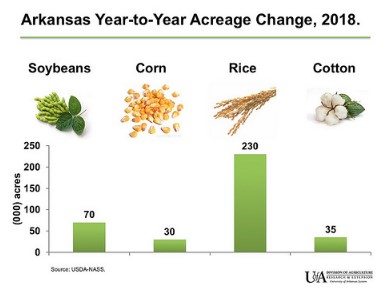By Mary Hightower
- Arkansas corn acres up to 650K.
- Sorghum adds 1,000 acres to 10,000.
- Rice acres increase to 1.39 million from 1.16 million last year.
- Soybeans increase to 3.6 million, up from 3.53 in 2017.
- Cotton moves from 455K to 480K acres in 2018.
- Peanuts steady at 30K acres.

The nation’s No. 1 rice producer added even more acres this year, and its soybean growers planted the most acres since 1997, according to the Arkansas numbers from Friday’s Acreage Report from the National Agricultural Statistics Service.
In Arkansas, the total crop acreage increased from 7.169 million acres to 7.556 million acres in 2018.
“As far as the Arkansas numbers go, the June Acreage was exactly the same as the March intentions for corn, cotton, soybeans, medium grain rice and peanuts,” he said. “The only adjustments were in grain sorghum and long grain rice.”
“Commodity prices for everything were higher this spring compared to 2017,” he said. “From January to May this year, new crop soybean futures averaged $10.34, corn about $4, and cotton 80 cents.”
CORN
Arkansas corn acreage rose 30,000 acres from 2017 to 650,000 acres.
COTTON
Cotton almost hit a half-million acres, clocking in at 480,000 acres in 2018, up from 445,000 last year. It’s the third straight year of increasing cotton acres in Arkansas, Stiles said.
“We’re seeing cotton in places we hadn’t seen it grown in 15 to 20 years,” said Bill Robertson, extension cotton agronomist for the Division of Agriculture.
“Their daddies and granddaddies grew cotton, but they hadn’t. The profit potential for cotton is starting to look better in the last few years.”
“China is having a tough time with their crop. India is having a tough time with its crop. Texas is having a hard time getting things planted,” he said.
Robertson also cited problems with another key competitor: polyester.
“There’s been a lot of pressure from the environmental community to start shutting down some of those polyester plants,” he said. “China had a ton of them. With low oil prices it was difficult to compete. Now, the main competition to cotton has fallen on some well-deserved hard times.”
GRAIN SORGHUM
“Growers backed off a bit on grain sorghum,” Stiles said. “Instead of the projected 15,000 planted acres expected in March, today's number came in at 10,000 -- up just 1,000 from last year's record low.”
PEANUTS
Arkansas peanut acreage remains the same as last year, 30,000 acres.
RICE
Arkansas, the nation’s top rice producer, still likes rice, with 1.391 million acres in the ground. California was next with 487,000, Louisiana third at 410,000 acres.
“Rice has picked up more acres this year than all the other major crops combined. USDA sees total rice acreage for the state up 230,000 over last year; most of that increase is long grain, which is up 215,000 acres.”
Jarrod Hardke, extension rice agronomist for the Division of Agriculture, said the 1.391 million acres was in line with his projection of 1.4 million. What surprised him was how those acres were distributed between medium and long grain. NASS put medium grain acres at 180,000.
“That is very shocking. I feel like we easily had 220,000 of medium grain, if not more,” he said. The 215,000 acre jump in long grain is “obviously substantial for a one-year jump and it’s odd that medium grain didn’t go up 15,000 over last year.”
Hardke said growers had what seemed to be non-stop rain in the spring, followed by non-start rain.
“Planting progress was way behind what we experienced in 2016 and 2017,” he said. “I was beginning to scale back my projections because we were not getting that opportunity to plant.”
Once the ground began to dry, low-laying areas in fields – the ones “that tend to flood out, go into rice,” Hardke said. “We planted almost all those areas that we hadn’t had the opportunity to plant in the last few years. That’s certainly something that helped drive getting to the acreage number we achieved.”
Stiles was surprised too.
“With soybean prices holding well above $10 this spring, I thought we might see some late rice acres shift to soybeans,” Stiles said. “It appears that didn't happen as NASS' soybean acreage for the state held steady from March to June at 3.6 million. Rice prices hit some lofty highs in late April and that kept growers from shifting rice acres to soybeans.”
SOYBEANS
Arkansas’ 3.6 million acres is the highest since 1997’s 3.65 million acres, Stiles said.
“This doesn’t surprise me, but it’s a little bit bigger than I was expecting considering there’s more interest in cotton and the rice prices,” Ross said.
Soybean growers will have an uphill slog this season.
“I don’t see us having yields like last year,” he said. In 2017, Arkansas saw a record state average yield.
“This is going to be a tough year for soybean growers,” Ross said. Last year had ideal conditions for the crop, but so far this season, “I don’t see the hot, dry conditions letting up in the near future.
“The big kicker for soybean growers is the drop in commodity prices,” he said. “This is not the year that we need to have economic issues. Our guys already spent a lot of money getting control of the weeds, irrigation costs will be up and insects are starting the blow up.”
WINTER WHEAT
Arkansas winter wheat acreage also declined from 200,000 acres planted last year to 180,000 this year.
OATS
Oats covered 12,000 acres, up from the 11,000 planted last year.
For more information on crop production and economics, visit uaex.edu or contact your county extension office.